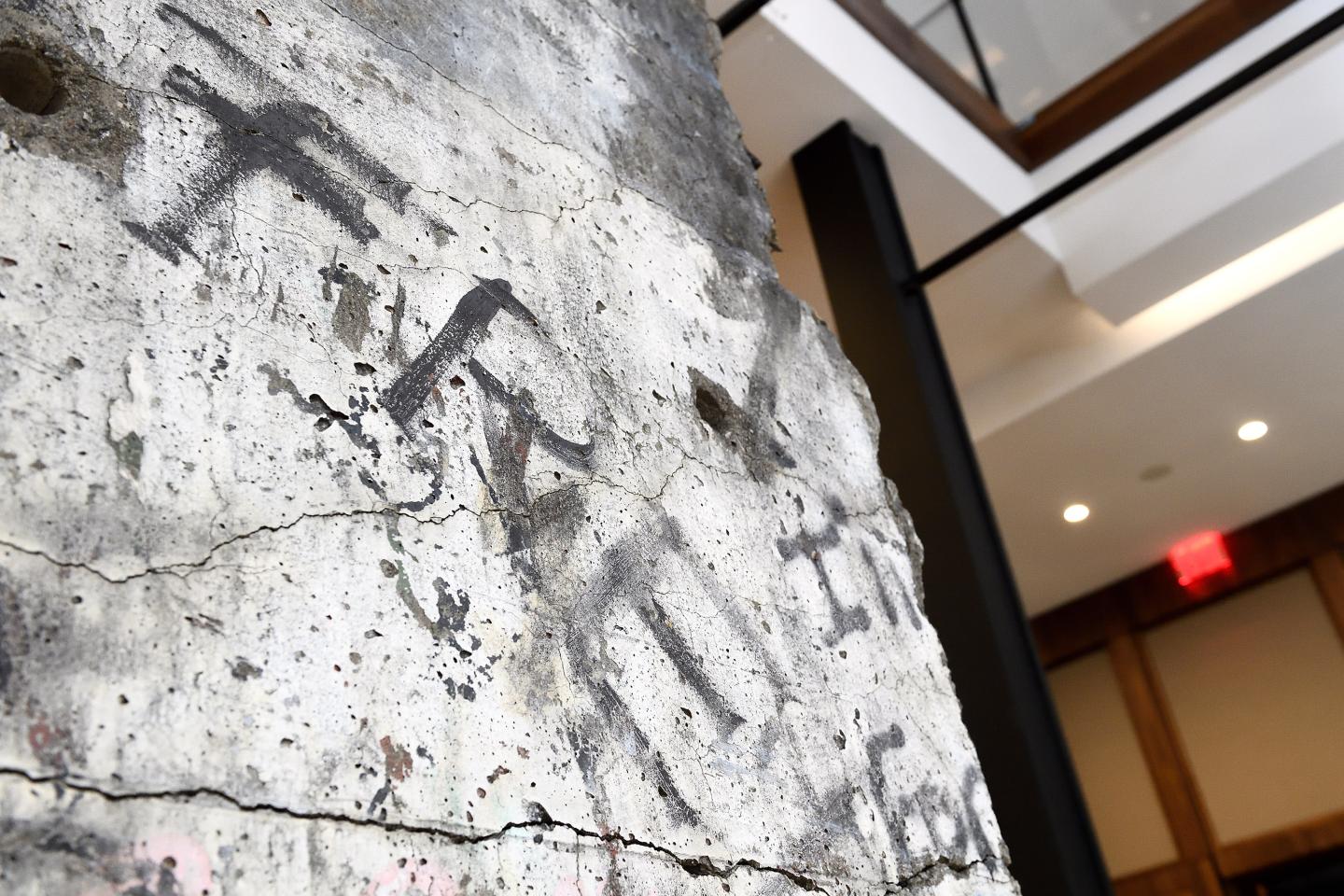Since its demolition in 1989, fragments of the Berlin Wall have found their way to unexpected corners of the globe—a casino bathroom in Las Vegas, a museum in the demilitarized zone between North and South Korea, and now, the Johns Hopkins University Bloomberg Center at 555 Pennsylvania Ave. in Washington, D.C.
The wall fragment first arrived at Johns Hopkins in 1997, when it was installed in the SAIS courtyard. It was a gift from the Berlin Senate acknowledging the role SAIS and the American Institute for Contemporary German Studies—now the American German Institute—played in fostering relations between the U.S. and postwar Germany.
Video credit: Roy Henry/Johns Hopkins University
Standing at an imposing 11 feet, 10 inches tall and weighing nearly 7,000 pounds, the wall fragment's journey required years of planning and a German naval ship for transport.
Jack Janes, president emeritus of the American German Institute, had envisioned something a bit smaller.
"We had a conference room, and I was thinking you'd have a piece installed there that would be 3, 4 feet tall as a way to memorialize the wall," Janes remembers. "But [a Berlin Senate member] said to me, 'There's one thing, Jack: These things are 3 or 4 meters tall.'"
It was 1994; in the short five years after the wall fell, the pieces that could be lifted without heavy machinery had already been claimed. With adjusted expectations, Janes braved the snowy Berlin winter to search the park where the wall's fragments had been dumped. He hoped for something eye-catching—something with color, maybe, or a poignant message scrawled in spray paint. Finally, he found an ideal piece half-submerged beneath the snow and rubble. On it, he could make out letters in graffiti: F-R-E. Surely, Janes assumed, the last letter was I, spelling the German word for "free." He was delighted. It wasn't until the full piece landed in D.C. a few years later that he realized he'd been mistaken.
"The last letter was D," he says with a laugh. "Fred."

Image credit: Will Kirk / Johns Hopkins University
The wall's dedication ceremony was attended by the foreign minister of Germany and the ambassador from Germany. A placard for the monument was unveiled as a testament to "the success of the German-American partnership and as a reminder that freedom can never be taken for granted."
When Janes heard SAIS was relocating to the Hopkins Bloomberg Center, he made sure the wall fragment wouldn't be left behind.
"I called to make sure that it went along when the move was made," he says. "I'm glad it's down there."
True to Janes' original vision, plans were made to house the wall fragment inside the building at 555 Pennsylvania Ave. But first, someone had to get it there.
Senior Design and Construction Project Manager June Emily Watkins oversaw the monument's relocation. To assist with the project, she assembled a team including Paul Nassetta, assistant director for Design and Construction; Matt Powers, senior project manager for Design and Construction; and Jackie O'Regan, curator from Collections and Academic Services.
Planning and preparation began in June. Movers needed to be hired. The floor at the Hopkins Bloomberg Center needed to be reinforced with steel to support the wall. A crane the size of a small house was needed to hoist the wall and carry it across downtown Washington. The first two tasks were simple enough, relatively speaking, but the latter required shutting down Massachusetts Avenue for several hours on a Saturday. If blocking one of Washington's main thoroughfares wasn't taxing enough, Watkins worried the wall might not make it in one piece.
"The wall presented a couple of concerns," she says. "The biggest for me was a large horizontal crack near the middle of the wall. Due to the nature of using the crane to pick the wall up and the fact that it would have to be turned on its side to enter the space, I was anxious about putting additional strain on that portion of the wall during those two phases of the move."
Thanks to the movers' meticulous work, the wall fragment remained intact, arriving safely at its destination that afternoon.
The final leg of the wall's journey fittingly took place during Secretary of State Anthony J. Blinken's Brzezinski lecture the following Wednesday, the inaugural address at the Hopkins Bloomberg Center. As Blinken gave an impassioned call for American diplomacy in an increasingly authoritarian post-Cold War political landscape, the movers worked quietly to move the wall, still in its crate, to its final location. The speech ended; the crowd filtered out. In the empty building, the crew painstakingly removed the wall from its crate. Several hours later, just as evening fell, the installation was complete.






